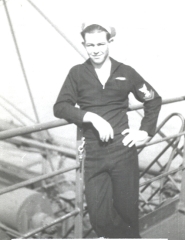Warren A. White

Warren A. White
WARREN
A.
WHITE
SOLDIER DETAILS
BIOGRAPHY
The only way I could be assured of going to the Navy instead of the Army was to join before I turned 18. So in late March 1944, I went to Kansas City, MO, to join on a delayed program which allowed me to finish high school. Five days after graduation I was called to active duty. On 5 Oct 1944, I reported aboard the USS Landing Craft Infantry 998, in San Diego harbor. Right after going aboard, the ship's captain told me to get more clothes. As I was flat broke, I had to wire home for money to get enough clothes to go to sea. The ship went to sea on 10 Oct taking 10 days to get to Pearl Harbor. That was my first experience on BIG water. On 1 Jan 1945 I was sent ashore to a radar school while radar equipment was being installed on my ship. Three days after returning to my ship, it left for the Marshall Islands. Our ship, now a staff ship for the Coast Guard Commander, was his command post and we were outfitted with the latest radio equipment for his convenience. As the ship left Pearl Harbor, carrying the 3rd Marine Division, the sea was rough and did I ever get sea sick. I had never been that sick before and it lasted about 24 hours. The invasion of Iwo Jima Island started on 19 Feb 1945. About 6 hours out, we could see the flashes from the big guns on the battle ships and heavy cruisers pounding the beaches of the island. About 2 hours out we could feel the concussion from the big guns. The 4th day, the Marines left our ship in the 3rd wave. Our commander wasn't very good about staying on station as he wanted to see and be seen. As a result, when the 1st US flag was raised on Mount Suribachi, our ship was just below the mount (about 200 yards away) and we could see the whole action very plainly. The surface of the harbor was covered with debris and litter of one sort or another. The first night our ship stayed in the invasion area all night, Japanese swimmers were reported in the water. Trying to blow up the ships with explosives attached to the hulls, they would get under some debris to stay out of sight while swimming. I was put on watch that night with a submachine gun on the bow and it was pretty frightening. I shot at everything I saw. The ship was at Iwo Jima 7 days and then left for Saipan and Leyte Harbor, Philippine Islands. We took on supplies and equipment and the 2nd wave troops for the new invasion. We left Leyte Harbor on 25 Mar 1945 and 6 days later we were participating in the invasion of Okinawa on 1 Apr 1945 (my 19th birthday). The Japanese 'Kamikaze' planes were very active here; one hit the ship next to us and some of our people were hit by shrapnel. We landed our troops and equipment on the second day. After the 8th day, we took our flotilla and left for the Caroline Islands, arriving on 17 Apr. On 1 May 1945 my rating for 3rd Class Radarman came through (it made little difference except for a little more pay). We left the islands on 7 Jun for Saipan again, arriving on 10 Jun 1945. I was allowed to go ashore and stay overnight with Don Billips, a close school buddy. I really enjoyed seeing someone from home. I got to see him twice more before we left for Leyte Harbor. There, we went on invasion maneuvers again, this time carrying the initial troops for the invasion of Japan proper. As the initial staging area, the harbor was completely full of ships and troops preparing for the invasion (over 2000 ships were at Leyte alone). On 10 Aug 1945 Japan announced their surrender. When the announcement was made that evening, the whole harbor went wild and the ships began shooting off their flares and pyrotechnics and spraying water from fire hoses into the air all night. When dawn came not one ship in the harbor had any flares or pyrotechnics left aboard. Japan signed the official surrender papers on 2 Sep 1945 aboard the Battle Ship USS Missouri in Tokyo Bay. Our ship, with our flotilla, left Leyte Harbor for Sasebo Harbor, Japan (a large Japanese Navy Base heavily damaged
 Eisenhower Foundation
Eisenhower Foundation
